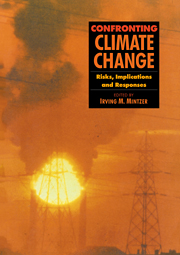Book contents
- Frontmatter
- Contents
- Foreword
- Acknowledgements
- List of Reviewers
- 1 Living in a Warming World
- I The Science of Climate Change
- 2 Linkages Between Global Warming, Ozone Depletion, Acid Deposition and Other Aspects of Global Environmental Change
- 3 Climate Sensitivity, Climate Feedbacks and Policy Implications
- 4 Lessons from the Ice Cores: Rapid Climate Changes During the Last 160,000 Years
- 5 Changes in Climates of the Past: Lessons for the Future
- 6 Indices and Indicators of Climate Change: Issues of Detection, Validation and Climate Sensitivity
- II Impacts of Global Climate Change
- III Energy Use and Technology
- IV Economics and the Role of Institutions
- V Equity Considerations and Future Negotiations
- Annex I
- Annex II
- Glossary
- Index
6 - Indices and Indicators of Climate Change: Issues of Detection, Validation and Climate Sensitivity
Published online by Cambridge University Press: 06 January 2010
- Frontmatter
- Contents
- Foreword
- Acknowledgements
- List of Reviewers
- 1 Living in a Warming World
- I The Science of Climate Change
- 2 Linkages Between Global Warming, Ozone Depletion, Acid Deposition and Other Aspects of Global Environmental Change
- 3 Climate Sensitivity, Climate Feedbacks and Policy Implications
- 4 Lessons from the Ice Cores: Rapid Climate Changes During the Last 160,000 Years
- 5 Changes in Climates of the Past: Lessons for the Future
- 6 Indices and Indicators of Climate Change: Issues of Detection, Validation and Climate Sensitivity
- II Impacts of Global Climate Change
- III Energy Use and Technology
- IV Economics and the Role of Institutions
- V Equity Considerations and Future Negotiations
- Annex I
- Annex II
- Glossary
- Index
Summary
Editor's Introduction
Choosing policy responses to reduce the risks of rapid climate change requires making decisions based on uncertain knowledge of the future. How can we know that the changes observed so far in regional climate records are not just part of the natural background “noise” —i.e., not just reflections of the inevitable stochastic variations of the climate system? In this chapter, three of the world's leading experts on the observation and measurement of atmospheric change address the question, “how can we know when a ‘real’ change in global climate is taking place?” In the process, Tom Wigley, Graeme Pearman, and Mick Kelly present an overview of the debate on whether signs of a greenhouse warming have been detected with sufficient confidence to prompt policy action by governments.
In the absence of any proof of greenhouse gas-induced warming, how can we validate our models of the global climate system and improve our ability to predict future climate change? One important way, these authors point out, is to compare the predictions from a model with the observations of the Earth's climate. But a number of inherent difficulties hinder our best efforts to validate “realistic” climate models. These are the “dirty window” effects described in this chapter, which include (for example) inherent uncertainties in the observations themselves and differences between the results of different models and types of numerical experiment. Moreover, the omnipresent, apparently meaningless, and clearly inescapable background noise inherent in the climate system obscures the signal that we are trying to see.
- Type
- Chapter
- Information
- Confronting Climate ChangeRisks, Implications and Responses, pp. 85 - 96Publisher: Cambridge University PressPrint publication year: 1992
- 6
- Cited by

